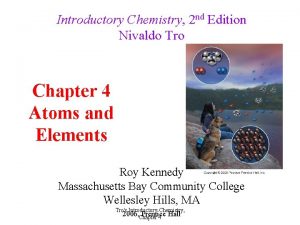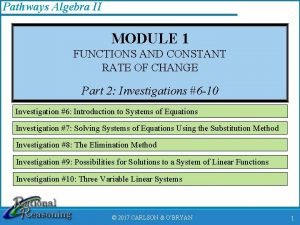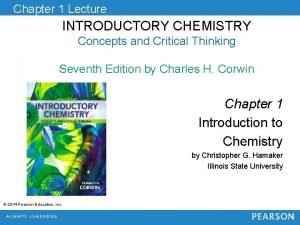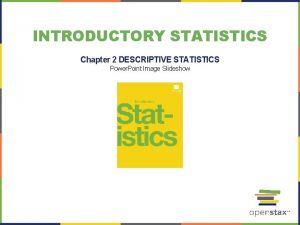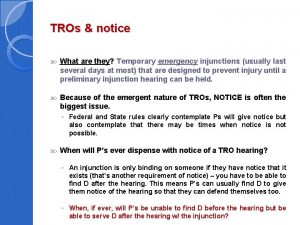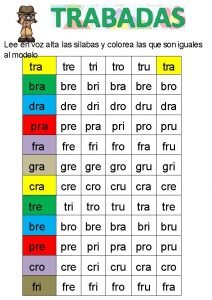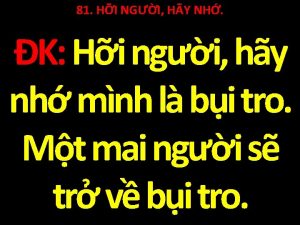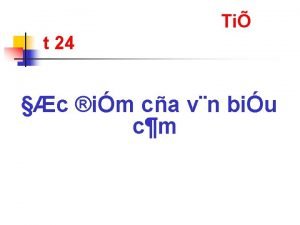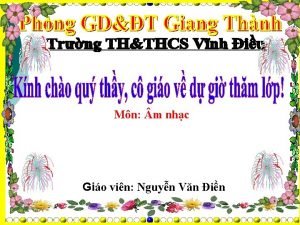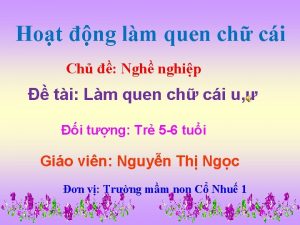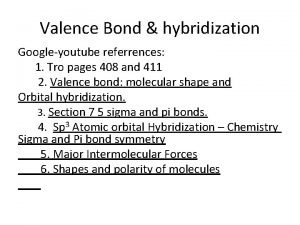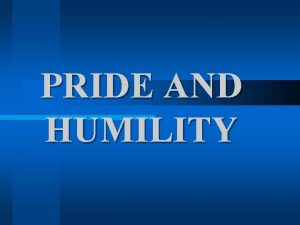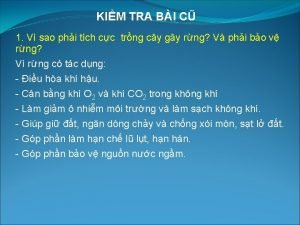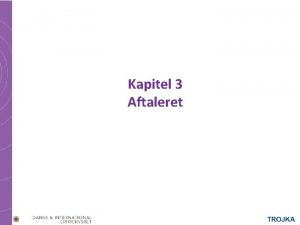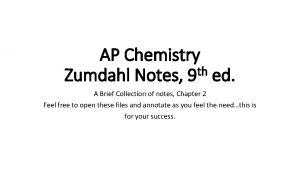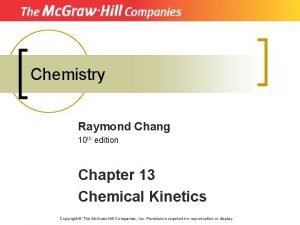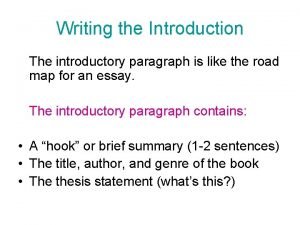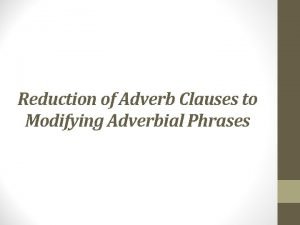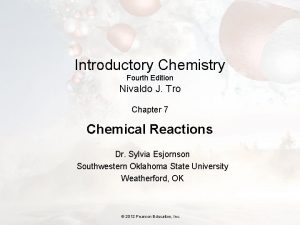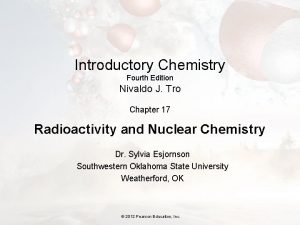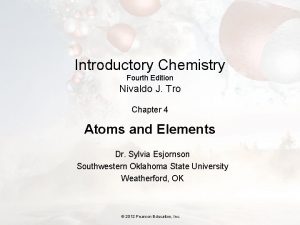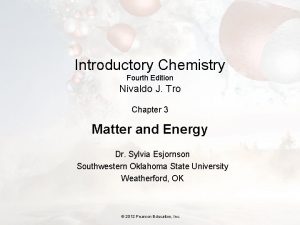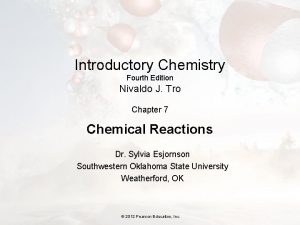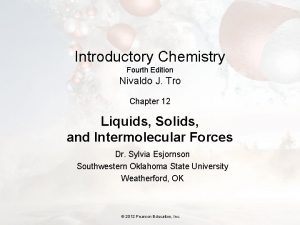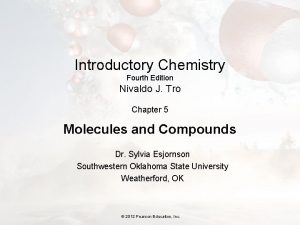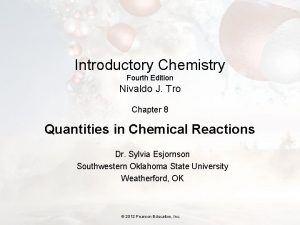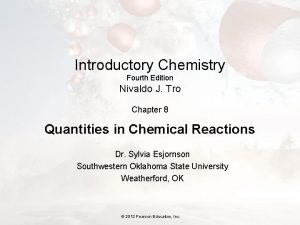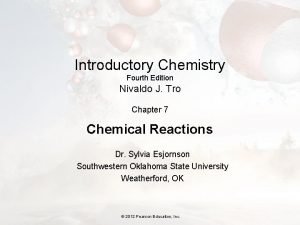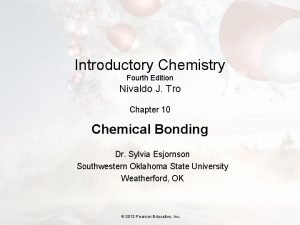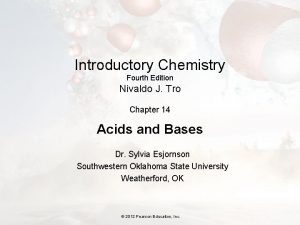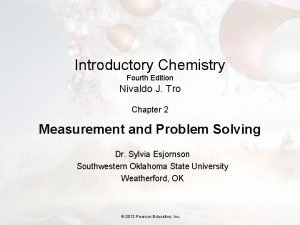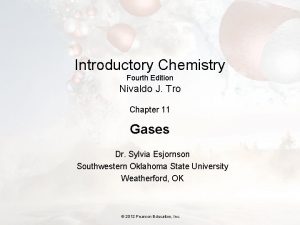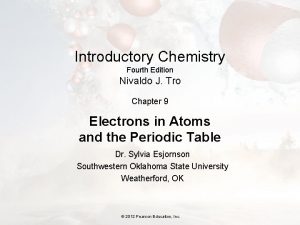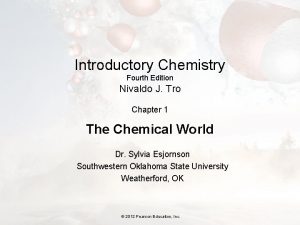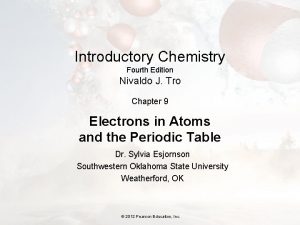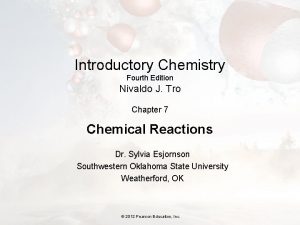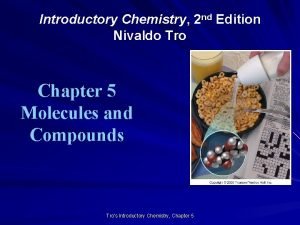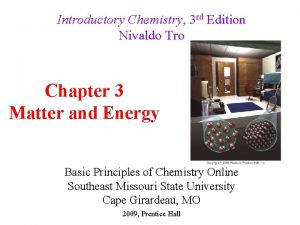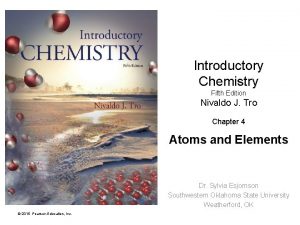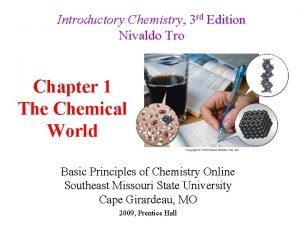Introductory Chemistry Fourth Edition Nivaldo J Tro Chapter



























































- Slides: 59

Introductory Chemistry Fourth Edition Nivaldo J. Tro Chapter 5 Molecules and Compounds Dr. Sylvia Esjornson Southwestern Oklahoma State University Weatherford, OK © 2012 Pearson Education, Inc.

5. 1 Sugar and Salt • Ordinary table sugar contains carbon, hydrogen, and oxygen atoms. • The properties of sugar are very different from those of carbon, shown here in the form of graphite, and hydrogen and oxygen. © 2012 Pearson Education, Inc.

5. 1 Sugar and Salt • FIGURE 5. 1 Elemental sodium Sodium is an extremely reactive metal that dulls almost instantly upon exposure to air. • FIGURE 5. 2 Elemental chlorine Chlorine is a yellow gas with a pungent odor. It is highly reactive and poisonous. © 2012 Pearson Education, Inc.

5. 1 Sugar and Salt • FIGURE 5. 3 Sodium chloride The compound formed by sodium and chlorine is table salt. • The properties of a compound are, in general, different from the properties of the elements that compose it. © 2012 Pearson Education, Inc.

5. 2 Compounds Display Constant Composition • Some of the substances we encounter in everyday life are elements. • Most are not elements—they are compounds. • In a compound, the elements combine in fixed, definite proportions. © 2012 Pearson Education, Inc.

5. 2 Compounds Display Constant Composition © 2012 Pearson Education, Inc.

5. 2 Compounds Display Constant Composition • Joseph Proust (1754– 1826) formally stated the idea that elements combine in fixed proportions to form compounds. • The law of constant composition states: All samples of a given compound have the same proportions of their constituent elements. © 2012 Pearson Education, Inc.

5. 2 Constant Composition: Mass Ratio • For example, if we decompose an 18. 0 g sample of water, we would get 16. 0 g of oxygen and 2. 0 g of hydrogen, or an oxygen-to-hydrogen mass ratio of • This is true of any sample of pure water, no matter what its origin. © 2012 Pearson Education, Inc.

5. 3 Chemical Formulas: How to Represent Compounds • A chemical formula indicates the elements present in a compound and the relative number of atoms of each. • For example, H 2 O is the chemical formula for water; it indicates that water consists of hydrogen and oxygen atoms in a 2: 1 ratio. • The formula contains the symbol for each element, accompanied by a subscript indicating the number of atoms of that element. By convention, a subscript of 1 is omitted. © 2012 Pearson Education, Inc.

5. 3 Chemical Formulas: How to Represent Compounds Common chemical formulas include: • Na. Cl for table salt, indicating sodium and chlorine atoms in a 1: 1 ratio. • CO 2 for carbon dioxide, indicating carbon and oxygen atoms in a 1: 2 ratio. • C 12 H 22 O 11 for table sugar (sucrose), indicating carbon, hydrogen, and oxygen atoms in a 12: 22: 11 ratio. • The subscripts in a chemical formula represent the relative numbers of each type of atom in a chemical compound; they never change for a given compound. © 2012 Pearson Education, Inc.

5. 3 Chemical Formulas: How to Represent Compounds CO and CO 2 • CO is the chemical formula for carbon monoxide, an air pollutant with adverse health effects on humans. – When inhaled, carbon monoxide interferes with the blood’s ability to carry oxygen, which can be fatal. – CO is the primary substance responsible for deaths of people who inhale too much automobile exhaust. • CO 2 is the chemical formula for carbon dioxide, the relatively harmless product of combustion and human respiration. We breathe small amounts of it all the time with no harmful effects. © 2012 Pearson Education, Inc.

5. 3 Chemical Formulas: • Chemical formulas list the most metallic elements first. – The formula for table salt is Na. Cl, not Cl. Na. • In compounds write a metal first, Metals are found on the left side of the periodic table and nonmetals on the upper right side. • Among nonmetals, those to the left in the periodic table are more metal-like than those to the right and are normally listed first. – We write NO 2 and NO, not O 2 N and ON. • Within a single column in the periodic table, elements toward the bottom are more metal-like than elements toward the top. – We write SO 2 not O 2 S. © 2012 Pearson Education, Inc.

5. 3 Chemical Formulas: • The specific order for listing nonmetal elements in a chemical formula is shown in Table 5. 1. • There a few historical exceptions in which the most metallic element is named first, such as the hydroxide ion, which is written as OH−. © 2012 Pearson Education, Inc.

5. 3 Polyatomic Ions • Some chemical formulas contain groups of atoms that act as a unit. • When several groups of the same kind are present, their formula is set off in parentheses with a subscript to indicate the number of that group. © 2012 Pearson Education, Inc.

polyatomic ions • Many of these groups of atoms have a charge associated with them and are called polyatomic ions. • To determine the total number of each type of atom in a compound containing a group within parentheses, multiply the subscript outside the parentheses by the subscript for each atom inside the parentheses. © 2012 Pearson Education, Inc.

Total Number of Each Type of Atom in a Chemical Formula • Determine the number of each type of atom in Mg(NO 3)2. • Mg(NO 3)2 indicates a compound containing one magnesium atom (present as the Mg 2+ ion) and two NO 3− groups. Mg: N: O: 1 = 1 Mg 1 × 2 = 2 N 3 × 2 = 6 O © 2012 Pearson Education, Inc.

Types of Chemical Formulas • An empirical formula gives the relative number of atoms of each element in a compound. • A molecular formula gives the actual number of atoms of each element in a molecule of the compound. • For example, the molecular formula for hydrogen peroxide is H 2 O 2, and its empirical formula is HO. • The molecular formula is always a whole number multiple of the empirical formula. • For many compounds, such as H 2 O, the molecular formula is the same as the empirical formula. © 2012 Pearson Education, Inc.

Images make the connection between the world around us and the world of atoms and molecules. • The macroscopic world (what we see) • The atomic and molecular world (the particles that compose matter) • The symbolic way that chemists represent the atomic and molecular world. • Here is an image of water using this kind of representation. © 2012 Pearson Education, Inc.

© 2012 Pearson Education, Inc.

Elements may be diatomic and molecular. • Molecular elements do not normally exist in nature with single atoms as their basic units. • Instead, these elements exist as diatomic molecules—two atoms of that element bonded together—as their basic units. © 2012 Pearson Education, Inc.

Elements may be atomic or molecular. The basic units that compose mercury, an atomic element and a metal, are single mercury atoms. The basic units that compose chlorine, a molecular element, are diatomic chlorine molecules, each composed of two chlorine atoms. © 2012 Pearson Education, Inc.

Elements that exist as diatomic molecules are shown in Table 5. 2. © 2012 Pearson Education, Inc.

Compounds may be molecular or ionic. • Molecular compounds are compounds formed from two or more nonmetals. The basic units of molecular compounds are molecules composed of the constituent atoms. • Ionic compounds contain one or more cations paired with one or more anions. © 2012 Pearson Education, Inc.

Compounds may be molecular or ionic. The basic units that compose dry ice, a molecular compound, are CO 2 molecules. The basic units that compose table salt, an ionic compound, are Na. Cl formula units. © 2012 Pearson Education, Inc.

Ionic Compounds • When a metal, which has a tendency to lose electrons, combines with a nonmetal, which has a tendency to gain electrons, one or more electrons transfer from the metal to the nonmetal, creating positive and negative ions that are attracted to each other. • A compound composed of a metal and a nonmetal is considered ionic. • Unlike molecular compounds, ionic compounds do not contain individual molecules but rather cations and anions in an alternating three-dimensional array. © 2012 Pearson Education, Inc.

5. 5 Writing Formulas for Ionic Compounds • Ionic compounds always contain positive and negative ions. • In the chemical formula, the sum of the charges of the positive ions (cations) must always equal the sum of the charges of the negative ions (anions). • Overall Ionic compounds are neutral. © 2012 Pearson Education, Inc.

5. 5 Writing Formulas for Ionic Compounds 1. Write the symbol for the metal and its charge followed by the symbol of the nonmetal and its charge. 2. Make the magnitude of the charge on each ion (without the sign) become the subscript for the other ion. 3. If possible, reduce the subscripts to give a ratio with the smallest whole numbers. 4. Check to make sure that the sum of the charges of the cations exactly cancels the sum of the charges of the anions. © 2012 Pearson Education, Inc.

Write a formula for the ionic compound that forms from magnesium and oxygen. © 2012 Pearson Education, Inc.

5. 6 Nomenclature: Naming Compounds • Chemists have developed systematic ways to name compounds. • Many compounds also have a common name. • H 2 O has the common name water and the systematic name dihydrogen monoxide. • Since water is such a familiar compound, everyone uses its common name and not its systematic name. • Common names can be learned only through familiarity; there is no system. © 2012 Pearson Education, Inc.

5. 7 Naming Ionic Compounds • The first step in naming an ionic compound is identifying it as one. • Remember, any time you have a metal and one or more nonmetals together in a chemical formula, you can assume the compound is ionic. © 2012 Pearson Education, Inc.

Ionic compounds can be categorized into two types, depending on the metal in the compound. © 2012 Pearson Education, Inc.

Ionic compounds can be categorized into two types, depending on the metal in the compound. • The first type (called Type I) contains a metal with an invariant charge—one that does not vary from one compound to another. • The second type of ionic compound (called Type II) contains a metal with a charge that can differ in different compounds. © 2012 Pearson Education, Inc.

transition metals • Such metals are usually (but not always) found in the transition metals section of the periodic table. • Some transition metals, such as Zn and Ag, form cations with the same charge in all of their compounds. • Some main group metals, such as Pb and Sn, form more than one type of cation. © 2012 Pearson Education, Inc.

Some Metals That Form More Than One Type of Ion with Their Common Charges © 2012 Pearson Education, Inc.

Naming Binary Ionic Compounds Containing a Metal That Forms Only One Type of Cation • Binary compounds are those that contain only two different elements. The names for binary ionic compounds containing a metal that forms only one type of ion have the form: © 2012 Pearson Education, Inc.

Naming Binary Ionic Compounds Containing a Metal That Forms Only One Type of Cation • For example, the name for Na. Cl consists of the name of the cation, sodium, followed by the base name of the anion, chlor, with the ending -ide. • The full name is sodium chloride. Na. Cl sodium chloride © 2012 Pearson Education, Inc.

The base names for various nonmetals and their most common charges in ionic compounds © 2012 Pearson Education, Inc.

Naming Binary Ionic Compounds Containing a Metal That Forms More Than One Type of Cation • Since the charge of the metal cation in these types of compounds is not always the same, the charge must be specified in the metal’s name. • We specify the charge with a Roman numeral (in parentheses) following the name of the metal. © 2012 Pearson Education, Inc.

Naming Binary Ionic Compounds Containing a Metal That Forms More Than One Type of Cation • For example, we distinguish between Cu+ and Cu 2+ by writing a (I) to indicate the 1+ ion or a (II) to indicate the 2+ ion: • Cu+ Copper(I) • Cu 2+ Copper(II) © 2012 Pearson Education, Inc.

Naming Binary Ionic Compounds Containing a Metal That Forms More Than One Type of Cation • The full name for these type of compound has the form: © 2012 Pearson Education, Inc.

Determine a charge from the formula of a specific compound. • We can determine the charge of the metal from the chemical formula of the compound. • The sum of all the charges must be zero. • The charge of iron in Fe. Cl 3 must be 3+ in order for the compound to be charge neutral with the three Cl- anions. © 2012 Pearson Education, Inc.

Naming Binary Ionic Compounds Containing a Metal That Forms More Than One Type of Cation The name for the compound Fe. Cl 3 is the name of the cation, iron, followed by the charge of the cation in parentheses (III), followed by the base name of the anion, chlor, with the ending -ide. • The full name is iron(III) chloride. Fe. Cl 3 iron(III) chloride © 2012 Pearson Education, Inc.

Naming Ionic Compounds Containing a Polyatomic Ion • Some ionic compounds contain polyatomic ions (ions that are themselves composed of a group of atoms with an overall charge). • Ionic compounds containing polyatomic ions are named using the same procedure we apply to other ionic compounds, except that we use the name of the polyatomic ion whenever it occurs. © 2012 Pearson Education, Inc.

The most common polyatomic ions are listed in Table 5. 6. © 2012 Pearson Education, Inc.

Naming Ionic Compounds Containing a Polyatomic Ion: Oxyanions • Many polyatomic ions are oxyanions, anions containing oxygen. • When a series of oxyanions contain different numbers of oxygen atoms, they are named systematically according to the number of oxygen atoms in the ion. • If there are two ions in the series, the one with more oxygen atoms is given the ending ate and the one with fewer is given the ending -ite. NO 3− nitrate NO 2− nitrite SO 42− SO 32− © 2012 Pearson Education, Inc. sulfate sulfite

Naming Ionic Compounds Containing a Polyatomic Ion • If there are more than two ions in the series, then the prefixes hypo-, meaning “less than, ” and per-, meaning “more than, ” are used. Cl. O hypochlorite Br. O hypobromite IO hypoiodite − Cl. O 2− chlorite Cl. O 3− chlorate Cl. O 4− perchlorate − Br. O 2− bromite Br. O 3− bromate Br. O 4− perbromate − IO 2− iodite IO 3− iodate IO 4− periodate When naming these ions in the homework, be sure to include the word ion in your answer, as in “perchlorate ion. ” © 2012 Pearson Education, Inc.

Everyday Chemistry: Polyatomic Ions • The active ingredient in household bleach is sodium hypochlorite, which acts to destroy color-causing molecules and kill bacteria. • Sodium nitrite is a food additive used to preserve packaged meats such as ham, hot dogs, and bologna. Sodium nitrite inhibits the growth of bacteria, especially those that cause botulism. © 2012 Pearson Education, Inc.

5. 8 Naming Molecular Compounds • Remember, nearly all molecular compounds form from two or more nonmetals. • We learn how to name binary (twoelement) molecular compounds. Their names have the form: © 2012 Pearson Education, Inc.

5. 8 Naming Molecular Compounds The prefixes given to each element indicate the number of atoms present. mono- 1 di- 2 tri- 3 tetra- 4 penta- 5 hexa- 6 hepta- 7 octa- 8 nona-9 deca-10 © 2012 Pearson Education, Inc.

5. 8 Naming Molecular Compounds If there is only one atom of the first element, the prefix mono- is normally omitted. CO 2 mono carbon di- ox -ide The full name is carbon dioxide. Since mono- ends with a vowel and oxide begins with a vowel, an o is dropped and the two are combined as monoxide. The entire name is dinitrogen monoxide N 2 O. © 2012 Pearson Education, Inc.

5. 9 Naming Acids • Acids are molecular compounds that start with H+. • They are composed of hydrogen, usually written first in their formula, and one or more nonmetals, written second. • We can categorize acids into two groups: non-oxy acids, those containing only hydrogen and a nonmetal, and oxy acids, those containing hydrogen, a nonmetal, and oxygen. © 2012 Pearson Education, Inc.

FIGURE 5. 14 Classification of acids © 2012 Pearson Education, Inc.

Naming Binary Acids • Binary acids are composed of hydrogen and a nonmetal. The names for binary acids have the following form: © 2012 Pearson Education, Inc.

Naming Binary Acids • HCl(aq) is hydrochloric acid. • HBr(aq) is hydrobromic acid. • HCl(g) refers to hydrogen chloride molecules in the gas phase, and not to the acid. • Give the name of H 2 S(aq). • The base name of S is sulfur, so the name is hydrosulfuric acid. © 2012 Pearson Education, Inc.

Naming Oxyacids • Oxyacids are acids that contain oxyanions—found in the table of polyatomic ions. • • HNO 3(aq) contains the nitrate NO 3− ion. H 2 SO 3 (aq) contains the sulfite SO 32− ion. H 2 SO 4 (aq) contains the sulfate SO 42− ion. These acids are a combination of one or more H+ ions with an oxyanion. • The number of H+ ions depends on the charge of the oxyanion, so that the formula is always chargeneutral. © 2012 Pearson Education, Inc.

HNO 2 Nitrous acid The names of acids containing oxyanions ending with -ite take this of oxyanion + ous form: HNO 3 Nitric acid The names of acids containing oxyanions ending with -ate take this form: oxyanion + ic © 2012 Pearson Education, Inc.

© 2012 Pearson Education, Inc.

Check the names © 2012 Pearson Education, Inc.

Chapter 5 in Review Chemical principles: • Compounds display constant composition. The elements that compose a particular compound are in fixed, definite proportions in all samples of the compound. • Chemical formulas indicate the elements present in the compound and the relative number of atoms of each. These formulas represent the basic units that compose a compound. • Chemical nomenclature: The names of simple ionic compounds, molecular compounds, and acids can all be written by examining their chemical formula. • Formula mass of a compound is the sum of the atomic masses of all the atoms in the chemical formula for the compound. © 2012 Pearson Education, Inc.
 Introductory chemistry 5th edition nivaldo j. tro
Introductory chemistry 5th edition nivaldo j. tro Introductory chemistry 5th edition answers
Introductory chemistry 5th edition answers Nivaldo j. tro introductory chemistry
Nivaldo j. tro introductory chemistry Introductory chemistry 4th edition
Introductory chemistry 4th edition Project 2 fourth edition
Project 2 fourth edition Pathways algebra 2 answer key
Pathways algebra 2 answer key Ethics in information technology fourth edition
Ethics in information technology fourth edition Ethics in information technology 6th edition answers
Ethics in information technology 6th edition answers Vertical line code in html
Vertical line code in html Discrete mathematics with applications susanna s. epp
Discrete mathematics with applications susanna s. epp Expert systems: principles and programming, fourth edition
Expert systems: principles and programming, fourth edition Introductory chemistry concepts and critical thinking
Introductory chemistry concepts and critical thinking Thermodynamic vs kinetic control
Thermodynamic vs kinetic control Organic chemistry (3rd) edition chapter 1 problem 20s
Organic chemistry (3rd) edition chapter 1 problem 20s Halohydrin
Halohydrin Using mis 10th edition
Using mis 10th edition Using mis 10th edition
Using mis 10th edition Chapter 2 descriptive statistics answer key
Chapter 2 descriptive statistics answer key Notice tro
Notice tro Con dra dre dri dro dru
Con dra dre dri dro dru Bài 2 cải tạo tu bổ vườn tạp
Bài 2 cải tạo tu bổ vườn tạp Hỡi người hãy nhớ mình là bụi tro
Hỡi người hãy nhớ mình là bụi tro Tò vò mà nuôi con nhện phương thức biểu đạt
Tò vò mà nuôi con nhện phương thức biểu đạt Giải phương trình bậc 1 sql
Giải phương trình bậc 1 sql Trò chơi khuông nhạc bàn tay
Trò chơi khuông nhạc bàn tay Trò chơi xem kịch câm
Trò chơi xem kịch câm Trò chơi chữ cái u ư chủ đề nghề nghiệp
Trò chơi chữ cái u ư chủ đề nghề nghiệp Valence bond formula
Valence bond formula Tro
Tro Trò chơi âm nhạc
Trò chơi âm nhạc Trò chơi có nhạc
Trò chơi có nhạc Gió vờn cánh hoa bay giữa trời
Gió vờn cánh hoa bay giữa trời Tro
Tro Vai trò của thực vật đối với động vật
Vai trò của thực vật đối với động vật Vai trò thực tiễn của lớp giáp xác
Vai trò thực tiễn của lớp giáp xác Re integra reglen
Re integra reglen ơn phù trợ chúng ta ở nơi danh chúa
ơn phù trợ chúng ta ở nơi danh chúa Trả lời câu hỏi nghĩa thầy trò
Trả lời câu hỏi nghĩa thầy trò Transition state energy diagram
Transition state energy diagram Klein organic chemistry 2nd edition
Klein organic chemistry 2nd edition The central science 14th edition
The central science 14th edition David klein organic chemistry
David klein organic chemistry Ap chemistry notes zumdahl
Ap chemistry notes zumdahl Organic chemistry third edition david klein
Organic chemistry third edition david klein General chemistry
General chemistry Lesson 81 drop in molecular views
Lesson 81 drop in molecular views Chemistry by raymond chang 10th edition
Chemistry by raymond chang 10th edition Democritus atomic model diagram
Democritus atomic model diagram Organic chemistry 2nd edition klein
Organic chemistry 2nd edition klein Organic chemistry second edition david klein
Organic chemistry second edition david klein Ib organic chemistry functional groups
Ib organic chemistry functional groups Inorganic vs organic chemistry
Inorganic vs organic chemistry Example of introductory paragraph with thesis statement
Example of introductory paragraph with thesis statement Lucy in the sky
Lucy in the sky Variables and expressions 1-1 answer key
Variables and expressions 1-1 answer key Counterargument
Counterargument News story example
News story example Introduction and background example
Introduction and background example Middle school introduction paragraph examples
Middle school introduction paragraph examples Modifying phrases
Modifying phrases


